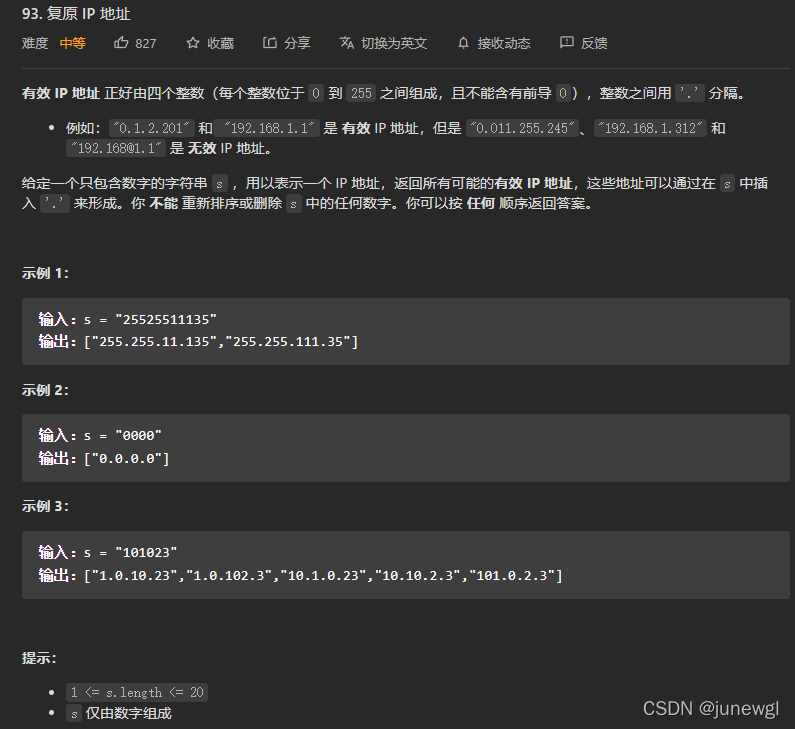1.题目

2.思路
一看见这个就是dfs的写法,或者叫做回溯的思想。
dfs(int index, int cnt, String temp, String s);
index : 遍历字符串的索引,最大为s.length()
cnt:记录当前已经拥有切分整数个数,最大为4
temp:记录当前已经形成的字符串,记得加点.
s:代表原来的字符串
// 时间复杂度:3^4 * 20
// 对于第一个节点来说,构造一棵树,有三个节点,树的深度最大为4,所以此时时间复杂度为3^4
// 总共有字符串大小的长度的节点,也就是20个。
// 所以最终时间为 3^4 * 20
class Solution {
List<String>ans = new ArrayList();
int n ;
public List<String> restoreIpAddresses(String s) {
n = s.length();
if(n <= 3)return ans;
dfs(0, 0, "", s);
return ans;
}
// cnt -记录切分的整数个数
// indeex -记录遍历的索引的位置
public void dfs(int index, int cnt, String temp, String s){
if(index == n){
if(cnt == 4){
ans.add(temp);
}
return ;
}
if(cnt == 4) return ; //代表后面还有数字
int preFlag = 1; //代表前面是否加.
if(index == 0) preFlag = 0;
// 可以选1,2,3位数字
for(int i = 1; i <= 3; i++){
String res = temp;
if(preFlag == 1)res = res + "." ;
if(index + i <= n){
String s2 = s.substring(index, index + i);
if(Double.parseDouble(s2) >=0 && Double.parseDouble(s2) <= 255 ){
if(i != 1 && s2.charAt(0) == '0'){
continue;
}
res += s2;
dfs(index + i, cnt + 1, res, s);
}
}
}
return ;
}
}时间复杂度如何分析? --3^4 * s.length()
dfs的时间复杂度分析基本一样的。--找树的子节点个数 和 树的深度,以及有多少颗这样的树!!
首先以第一个节点为例,可以产生3个子节点(也就是三个dfs(),对于当前元素,可以有三个不同的操作, 选择1位,选择2位,选择3位,因为数字范围是0-255,所以最大是3位,最小是1位。)对于第一个节点形成的树,深度大小为4,因为最多只能有四次这样的操作,因为IP地址整数个数为4,所以这个节点的时间复杂度为 3^4.
当第一个节点的树都遍历完后,那么下一个节点可能就是选择前2个数作为起点,再下一个起点就是选择前3个节点作为起点,按照答案的意思,可以选择前20个数作为起点,所以是有20颗这样的树。所以最终为3^4 * s.length()。实际过程中会比这个少很多,因为会有结束条件提前结束。
3.结果

4.感想
2.注意什么时候要回溯,什么时候不回溯。
这里没有回溯,是因为我单独取了一个遍历来保存结果,所以没有回溯。
2.注意学会分析时间复杂度。





















 208
208











 被折叠的 条评论
为什么被折叠?
被折叠的 条评论
为什么被折叠?








